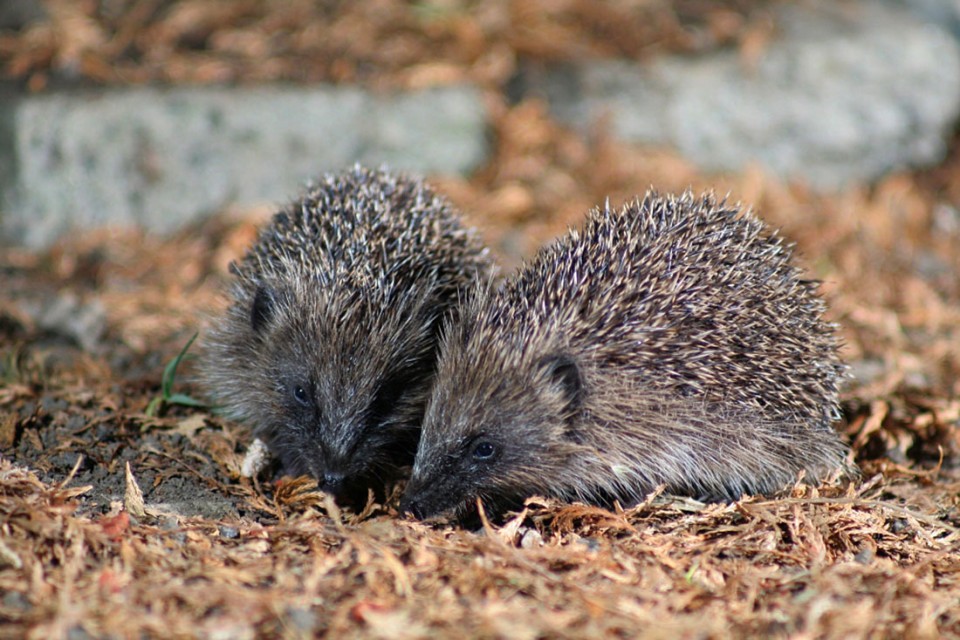European Hedgehog Territory & Home Range
The largely solitary nature of hedgehogs long implied that they maintained exclusive home ranges, but evidence of territoriality was hard to find. The advent of radio-tracking has given us a better insight into their movements and it seems to vary with sex and breeding status. Tracking of male hedgehogs has shown that they move widely and their range encompasses the ranges of several females and, sometimes, other males. Females, however, appear to be more exclusive. Observations in Switzerland by Guy Berthoud, published in La Terre et al Vie in 1978, indicated contiguous but non-overlapping territories among female hedgehogs. Similarly, tracking studies on hedgehogs in Finland by Anni Rautio and colleagues recorded a more exclusive home range use among female than males, with females sharing home ranges with other females only outside of the breeding season. This may, however, be a response to nursing females staying close to their breeding nests and therefore not overlapping ranges with neighbouring sows.
Overall, we have no data to corroborate the existence of territoriality in hedgehogs. Observations of fights between individuals kept in captivity, or around feeding stations (see Behaviour and Social Structure), are more likely to represent defence of the kinosphere (i.e. interpersonal distance) than territoriality. Furthermore, territorial species typically mark the boundaries of their range with scent, usually urine and faeces, but hedgehogs deposit their droppings at random. Berthoud didn’t observe any marking behaviour in his study population, nor were any of the frequent movements into other females’ ranges seemingly met with aggression. It is theoretically possible that hedgehogs scent mark with urine but, as pat Morris notes in his The New Hedgehog Book, hedgehog urination is impossible to document because it is done so unobtrusively.

The ranging behaviour of hedgehogs is individual-specific. Some animals appear to wander nomadically, while others can reliably be found in the same range over consecutive months or even years. Those that use a home range seem able to remember the boundaries well, despite the apparent lack of scent-marking. Experiments by John Lamming, described by Les Stocker in The Complete Hedgehog, found that hogs moved around Brownsea Island in Hampshire always found their way back home, running from the release site at an average of 466 metres per hour (about 0.3 mph) and slowing to 180 m/h (0.1 mph) as they re-entered their home range and started foraging.
Home ranges size is determined by the distribution of essential resources such as food, water, shelter, and mates. As such, hedgehogs typically range over smaller areas in towns and cities, where resources tend to be more concentrated, than those in rural pasture. A study tracking the hedgehog population in Zurich, Switzerland, for example, found that the nightly range, and therefore the home ranges, of urban hedgehogs were substantially shorter than those of their rural conspecifics.
Mathematical models applied to hedgehog bioenergetics suggest that the minimum area over which a hedgehog should range, considering patchy distribution of resources, is between three and six hectares (7 to 15 acres); these estimates fit well with the smallest ranges calculated from radio-tracking data, although considerably larger ranges appear common. In Finland, the northern limit of this species’ distribution, Anni Rautio and colleagues observed males consistently moving over larger ranges than females in all seasons except immediately prior to hibernation. In their 2013 paper to Annales Zoologici Fennici, Rautio and her co-workers report average home ranges for males and females of 82 and 30 hectares (200 and 74 acres), respectively.

Tracking and mark-recapture studies by Pat Morris and Nigel Reeve suggest that, in the UK, male hedgehogs have an average home range of about 32 ha (70 acres), while females move over an area of only 10 ha (almost 25 acres). Similarly, tracking studies of hedgehogs in Ireland led by Amy Haigh have revealed the average male home range to be 56 ha (almost 140 acres), while females ranged over only about 16.5 ha (41 acres).
More recently, a team at Oxford University’s WildCRU led by Carly Pettett recorded male and female home ranges of about 22 ha and 12 ha, respectively, based on tracking 33 animals in Norfolk and north Yorkshire. Moreover, Pettett and her colleagues observed that hedgehogs in areas with known badger populations had smaller home ranges than those in badger-free habitats. On average, hedgehogs living in areas with badgers had home ranges 12 ha smaller than those living away from badgers, suggesting that badgers may restrict hedgehog movement (fragment the landscape), although this decline couldn’t be attributed to badger presence alone. In the presence of badgers, the hedgehogs also stayed closer to buildings and used surrounding arable land less than those in badger-free areas.
This sex-biased ranging doesn’t appear to be the result of food availability. A study by Pat Morris published in Mammal Review during 1985 looked at the impact supplementary feeding had on movements of the local hedgehog population and found, despite the presence of abundant food supplied by householders, males still ranged 75% further than females. (In his New Hedgehog Book, Morris suggests that males might wander even further in areas where there is less food to delay them.) Instead, the greater ranging of males has largely been presumed a search for potential mates, although it’s not always a clear association.

Nigel Reeve was unable to detect any clear pre- and post-mating period during his studies in London; sexual activity spanned almost their entire active period, from mid-May to September. Nonetheless, a Swedish study found a clear reduction in male activity after about mid-July, when the breeding season is winding down, although males still ranged further than females overall. In Ireland, Amy Haigh observed something similar, with both sexes reducing their home ranges to about five hectares (12 acres) during August when the percentage of time spent in courtship dwindled and the time spent feeding more than doubled.